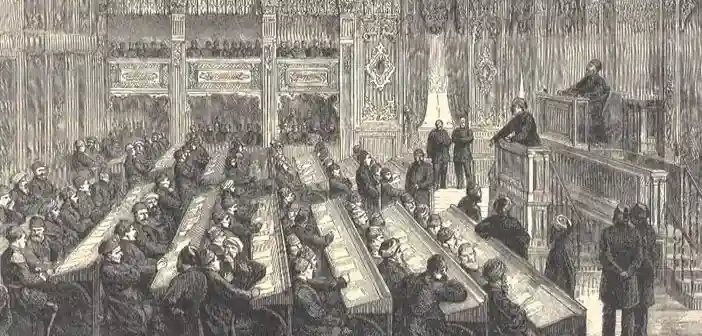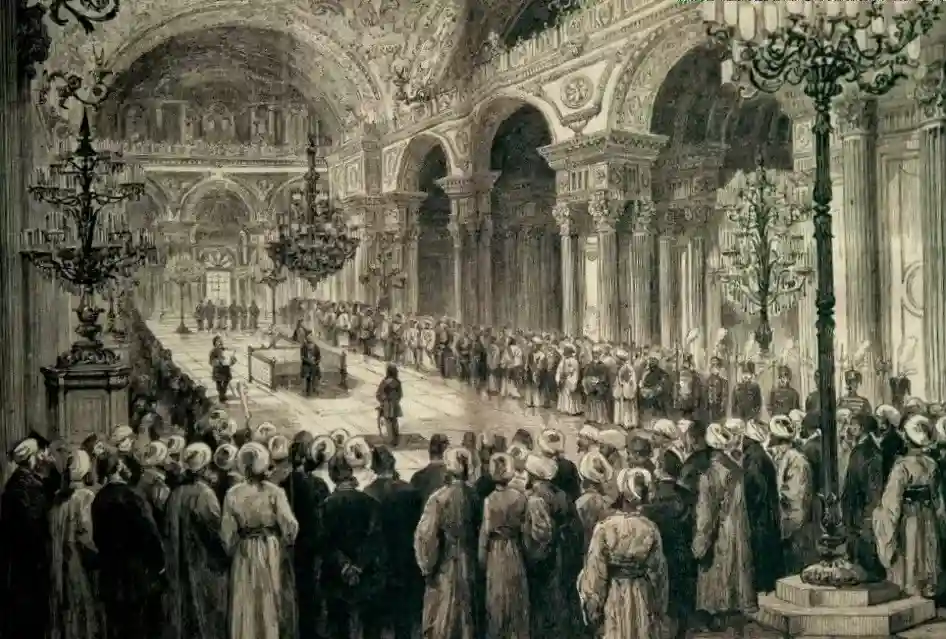The First Constitution of the Ottoman Empire, In the early 19th century, the Ottoman Empire faced serious economic, social and political problems. The beginning of the industrial revolution in Europe and the backwardness of the Ottoman Empire compared to Western states made reform movements within the empire inevitable. During this period, the Tanzimat Edict was declared in 1839 and the Islahat Edict in 1856. These edicts are considered the first steps of the Ottoman Empire’s modernization efforts.
Tanzimat Edict (1839)
The Tanzimat Edict is a reform document that aims to establish modern state concepts such as the rule of law, equality and justice in the Ottoman Empire. The edict limited the absolute authority of the sultan and granted some basic rights and freedoms to citizens. The declaration of this edict played an important role in paving the way for the First Constitution of the Ottoman Empire.
Reform Edict (1856)
The Reform Edict is a document that was declared after the Tanzimat Edict and foresaw more comprehensive reforms in the Ottoman Empire. With this edict, equality was established between Muslim and non-Muslim citizens and freedom of religion and conscience was guaranteed. The Reform Edict was an important turning point in the process of declaring the First Constitution of the Ottoman Empire.
The Preparation Process of the First Constitution of the Ottoman Empire
The Period of Abdulaziz
The process of preparing the First Constitution of the Ottoman Empire began during the reign of Sultan Abdulaziz. Abdulaziz gave importance to reforms in order to strengthen relations with Western states and increase the reputation of the Ottoman Empire in the international arena. However, the economic crises and internal turmoil experienced during Abdulaziz’s reign prevented the reforms from being fully implemented.
Mithat Pasha and the Constitutional Commission
After the dethronement of Abdulaziz, the reign of Abdulhamid II began and the process of preparing the First Constitution of the Ottoman Empire gained momentum during this period. Mithat Pasha played an important role in the preparation of the constitution and assumed the presidency of the Kanun-i Esasi Commission. The commission prepared a constitution suitable for the Ottoman Empire, inspired by western constitutions.
The First Constitution of the Ottoman Empire: The Fundamental Law (1876)
General Structure
The first constitution of the Ottoman Empire, namely the Kanun-i Esasi, was declared on December 23, 1876. The constitution consisted of a total of 119 articles and limited the powers of the sultan to a certain extent, introducing a constitutional monarchy. The constitution regulated the duties and powers of the legislative, executive and judicial bodies.
Powers of the Sultan
According to the Constitution, the sultan’s powers were limited to a certain extent. Although the sultan had the power to approve and veto the decisions of the legislative assembly, the assembly was also allowed to work independently. The constitution aimed to establish the rule of law and the parliamentary system in the Ottoman Empire by weakening the absolute authority of the sultan.
Legislative Power
The Basic Law gave legislative authority to two assemblies: the Chamber of Deputies and the Chamber of Ayan. While the Chamber of Deputies was composed of members elected by the people, the members of the Chamber of Ayan were appointed by the sultan. This structure ensured the beginning of a democratic legislative process in the Ottoman Empire.
Executive Power
The executive authority was exercised by the sultan and the government appointed by him. The government consisted of the grand vizier (prime minister) and other ministers. The constitution determined the powers and responsibilities of the government and ensured that the executive body was accountable to the parliament.
Jurisdiction
The Constitution guaranteed the independence of the judiciary. The Constitution determined the duties and powers of the judicial bodies and ensured that the courts worked independently. In this way, the principle of the rule of law was adopted in the Ottoman Empire.

The First Constitution of the Ottoman Empire: The Effects of the Constitution
Political Influences
The Constitution made significant contributions to the modernization of the political structure within the empire. The constitution established a constitutional monarchy and initiated the transition to democracy in the Ottoman Empire. However, the suspension of the constitution and the closure of the parliament by Abdulhamid II shortly afterwards limited the effects of the constitution.
Social Impacts
The Constitution contributed to the establishment of social justice in Ottoman society and the guarantee of the fundamental rights and freedoms of citizens. The Constitution is considered an important step in the modernization process of the Ottoman Empire and encouraged the coexistence of different segments of society.
Economic Impacts
The Constitution also had some effects in the economic field. The constitution made the economic policies of the state more transparent and accountable, which increased the confidence of foreign investors in the Ottoman Empire. However, economic problems and debts limited the economic effects of the constitution.
Legal Effects
The Constitution made radical changes in the Ottoman legal system. The Constitution adopted the principle of the supremacy of law and guaranteed the independence of the judiciary. This played an important role in laying the foundations of the modern Turkish legal system.
Short-Term Application of the Fundamental Law and Its Results
Period of Abdulhamid II
When Abdulhamid II ascended to the throne in 1876, he declared the constitution, but soon after, he closed the parliament and suspended the implementation of the constitution. Abdulhamid II’s authoritarian rule rendered the constitution ineffective and the constitutional monarchy was interrupted.
The Second Constitutional Monarchy and the Re-Proclamation of the Constitution
The Second Constitutional Era, which took place in 1908, led to the re-declaration of the Constitution. During this period, the constitution was implemented more effectively and the democratization process in the Ottoman Empire accelerated. However, World War I and the collapse of the empire limited the long-term effects of the constitution.
The Republican Era and the Legacy of the Constitution
The Constitution left an important legacy in the establishment of the modern Republic of Turkey. With the declaration of the Republic, the principles of constitutional government and the rule of law became the cornerstones of the Turkish legal system. The Constitution is considered an important milestone in Turkey’s transition to democracy.
The first constitution of the Ottoman Empire, Kanun-i Esasi, emerged as a result of the modernization efforts of the Ottoman Empire. Kanun-i Esasi constituted the cornerstones not only of Ottoman history but also of the modern Republic of Turkey. Kanun-i Esasi introduced universal values such as the rule of law, judicial independence and democracy to Ottoman society. Although Kanun-i Esasi was implemented for a short time, it is considered an important step in the modernization process of the Ottoman Empire. In this article, the historical background, preparation process, content and effects of Kanun-i Esasi are discussed in detail. Kanun-i Esasi is of great importance in terms of understanding both Ottoman history and the modern Turkish legal system. Therefore, the examination and understanding of Kanun-i Esasi should be considered a valuable study in historical and legal terms.
